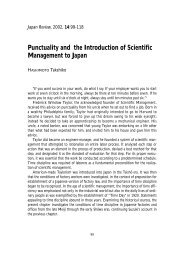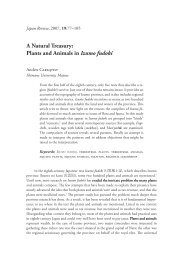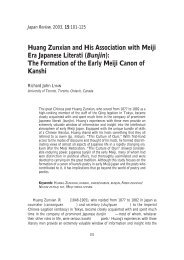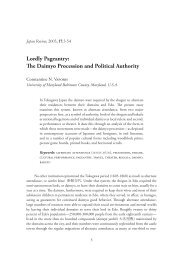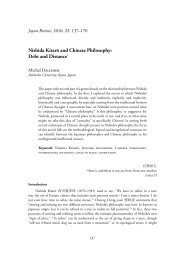Meiji shinkyoku - 国際日本文化研究センター
Meiji shinkyoku - 国際日本文化研究センター
Meiji shinkyoku - 国際日本文化研究センター
Create successful ePaper yourself
Turn your PDF publications into a flip-book with our unique Google optimized e-Paper software.
112 Philip Flavin<br />
to illustrate the signifi cance and implications of Tateyama’s innovations.<br />
Kaede no hana is recognized as one of the great <strong>Meiji</strong> <strong>shinkyoku</strong> and represents what may<br />
be considered the musical norm for the fi rst phase <strong>Meiji</strong> works.Th is composition is over twenty<br />
minutes long which makes reduction impossible. However, the process of Westernization<br />
can be readily understood through changes in the instrumental sections. Th e section given<br />
below consists of a kakeai 掛け合い, that is the exchange of melodic material between two<br />
instruments, and its climax, which is then followed by a shift to a more orthodox texture. 40 Th e<br />
contour of all kakeai resembles the example here with the exchange of two clear melodic phrases<br />
followed by increasingly shorter gestures that conclude on a unison or an octave. Th is kakeai,<br />
for example, ends on the A in the middle of the third system or line. Kakeai normally return<br />
to the stereotypical texture that follows. Th e length and rhythmic regularity of the antecedent<br />
consequent phrases suggest a metrical framework of 4/4; however, to assign this or any other<br />
time signature would be an error. Th e Edo/early <strong>Meiji</strong> composers’ perception of metre was<br />
limited to hyōshi 拍子, a unit composed of a strong beat followed by a weak beat. 41 Th e idea<br />
of grouping hyōshi into larger units, or of a relationship between melodic length and larger<br />
groupings, would have been foreign. (I have sought to represent this perception by removing<br />
Figure 2 a: Kaede no hana—tegoto (excerpt) comp. 1897, Matsuzaka



